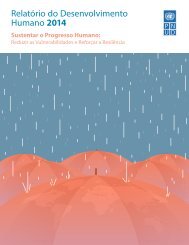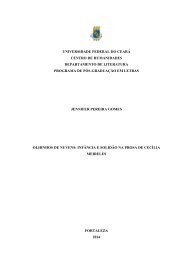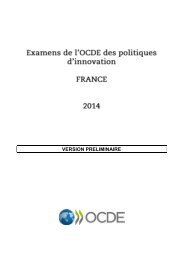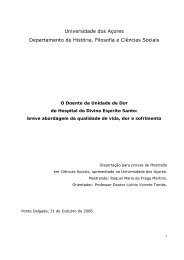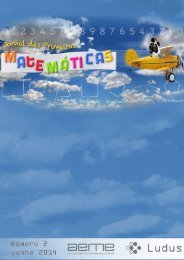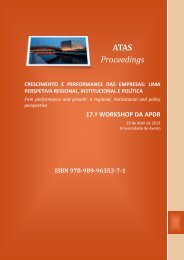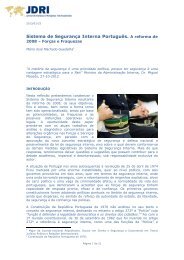1POTXAdSn
1POTXAdSn
1POTXAdSn
You also want an ePaper? Increase the reach of your titles
YUMPU automatically turns print PDFs into web optimized ePapers that Google loves.
notas explicativas<br />
O filo Platyhelminthes (platy = chato; helmintos =<br />
verme) reúne os animais invertebrados com corpo<br />
achatado dorsoventralmente, triblásticos, acelomados<br />
apresentando simetria bilateral. São também conhecidos<br />
como vermes achatados, com enorme capacidade<br />
de explorar uma grande variedade de habitats, desde<br />
sistemas aquáticos, solos até parasitas de animais. Este<br />
taxon está divido em dois subfilos: os Turbellaria de<br />
vida livre, caracterizados por uma epiderme ciliada; e<br />
os Neodermata, parasitas que numa altura do seu ciclo<br />
de desenvolvimento substituem a epiderme ciliada<br />
pela neoderme.<br />
A actual informação sobre os platelmintes terrestres<br />
do arquipélago dos Açores encontra-se fraccionada<br />
e espalhada em diversos relatórios e publicações<br />
científicas. Embora a fauna dos Açores seja objecto<br />
de estudo em diversas áreas, este grupo encontra-se<br />
numa fase de estudo bastante preliminar, sendo difícil<br />
ter uma ideia geral acerca da biodiversidade e riqueza<br />
de espécies do mesmo. Os poucos estudos realizados<br />
sobre este grupo envolveram na sua maioria uma única<br />
amostragem e incidiram apenas sobre a análise qualitativa<br />
das espécies presentes. O primeiro trabalho data<br />
do século XIX, durante a visita de Barrois (1896) ao<br />
arquipelágo. Mais tarde, Marcus e Marcus (1959) deram<br />
novos registos após revisão das colecções efectuadas<br />
por Brinck e Dahl durante a expedição da Lund<br />
University em 1957, aos arquipélagos da Madeira e<br />
dos Açores. Posteriormente, o estudo dos platelmintes<br />
centrou-se nas formas parasíticas devido à importância<br />
nas áreas da medicina e veterinária (Afonso-Roque<br />
1989; Casanova et al. 1996; Foronda et al. 2003,<br />
2009; Viveiros, 2009). Recentemente, os sistemas dulçaquícolas<br />
têm sido objecto de estudo na região, fundamentalmente<br />
devido à implementação da Directiva<br />
Quadro da Água, que contribuiu para confirmar a presença<br />
de algumas espécies registadas no século passado,<br />
mas também para assinalar a presença de novos<br />
registos para a região (Malhão et al. 2007).<br />
Assim, a lista de platelmintes apresentada neste capítulo<br />
tem por base as publicações conhecidas e alguns<br />
trabalhos não publicados. A classificação utilizada segue<br />
o delineado para as espécies europeias terrestres do<br />
projecto Fauna Europaea (http://faunaeur.org). Os taxa<br />
148<br />
explanatory notes<br />
The Phylum Platyhelminthes (platy = flat; helmintos<br />
= worm) is characterized by dorsoventral flattened<br />
animals, triploblastic, acelomate with bilateral<br />
symmetry, also known as flatworms. These animals<br />
possess the ability to explore a wide range of habitats<br />
such as aquatic systems and soils and can also be found<br />
as parasites of other animals. This group is divided<br />
into two subphylums: the free-living Turbellaria<br />
- characterized by the ciliated epidermis; and the<br />
parasitic Neodermata - where, at some stage of their<br />
development, the original ciliated epidermis is shed<br />
and replaced by a new body lining, the neodermis.<br />
The current information about the terrestrial<br />
flatworms of the Azores archipelago is fractional and<br />
spread throughout several scientific publications.<br />
Although the Azorean fauna is the subject of study in<br />
several areas, this group has been neglected thus far,<br />
making it very difficult to get a general idea about its<br />
diversity and richness.<br />
The few studies, carried out in the Azores on this<br />
group, only included isolated collection events and a<br />
brief qualitative analysis on the detected species. The<br />
first work was conducted by Barrois (1896) during<br />
his visit to the archipelago in the nineteenth century.<br />
Later, Marcus and Marcus (1959) provided additional<br />
records from collections made by Brinck and Dahl<br />
during the Lund University Expedition to the Azores<br />
and Madeira archipelagos in 1957. Recently, studies<br />
on the parasitic flatworms gained an increased interest<br />
due to their importance in the medical and veterinary<br />
fields (Afonso-Roque 1989; Casanova et al. 1996;<br />
Foronda et al. 2003, 2009 and Viveiros 2009).<br />
With the Water Frame Directive implementation<br />
the number of freshwater studies has increased in<br />
the region. This emphasis in freshwater systems<br />
helped to confirm the presence of some flatworm<br />
species previously described but also allowed for<br />
new species records within the archipelago (Malhão<br />
et al. 2007).<br />
The current flatworms list here presented is based<br />
on known publications and unpublished work. The<br />
species classification system used follows the one<br />
outlined in the recent list of European terrestrial species<br />
from the Project Fauna Europaea (http://faunaeur.org).





